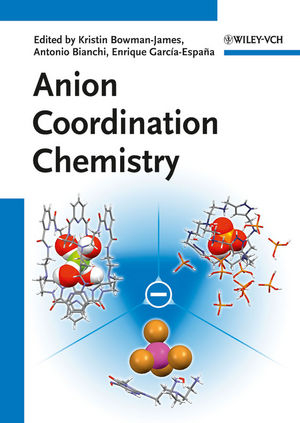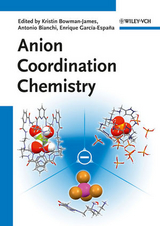Anion Coordination Chemistry
Wiley-VCH (Verlag)
978-3-527-32370-8 (ISBN)
- Titel ist leider vergriffen;
keine Neuauflage - Artikel merken
Some of the hottest advances in chemistry are made within supramolecular chemistry or host-guest chemistry. The coordination of anions is a part of supramolecular chemistry that is important in many areas, such as biochemistry, environmental studies and the design of chemical sensors.
Building on the pioneering work in supramolecular chemistry from the last 20 years or so, this monograph addresses new and recentapproaches to anion coordination chemistry. Synthesis of receptors, biological receptors and metallareceptors, the energetics of anion binding, molecular structures of anion complexes, sensing devices are presented and computational studies addressed to aid with the understanding of the different driving forces responsible for anion complexation. The reader is promised an actual picture of the state of the art for this exciting and constantly evolving field of supramolecular anion coordination chemistry. The topics range from ion channels to selectivesensors, making it attractive to all researchers and PhD students with an interest in supramolecular chemistry.
Kristin Bowman-James received her Ph.D. in Chemistry at Temple University in Philadelphia, Pennsylvania, USA. She joined the Chemistry Department at the University of Kansas in 1975 and is currently University Distinguished Professor of Chemistry. Her research bridges across the fields of supramolecular and transition metal coordination chemistry. She is an experienced author with over 100 papers, many reviews, has served as Editor for three books, and has received awards for both research and service. Antonio Bianchi received his Ph.D. in Chemistry at University of Florence in Italy in 1989. He was employed by the university first as a tenured Researcher, then as an Associate Professor, and from 2000 as Professor of General and Inorganic Chemistry. From 2006 to 2009 he served as the Head of the Department of Chemistry of the said university. His diverse research interests encompass inorganic chemistry, supramolecular chemistry, coordination of anions, metallo-receptors and thermodynamics of coordination compounds. He has authored over 200 papers and has served as editor of the book "The Supramolecular Chemistry of Anions" with his current co-editors. Enrique García-España Monsonís received his Ph.D. in Chemistry at University of Valencia in Spain. After a period working in industry, he returned to the University of Valencia and held an assistant Professor position before becoming Professor at the Department of Inorganic Chemistry in 2000. He has worked within Supramolecular Chemistry since 1984 and has authored or co-authored over 215 papers.
Preface
ASPECTS OF ANION COORDINATION FROM HISTORICAL PERSPECTIVES
Introduction
Halide and Pseudohalide Anions
Oxoanions
Phosphate and Polyphosphate Anions
Carboxylate Anions and Amino Acids
Anionic Complexes: Supercomplex Formation
Nucleotides
Final Notes
THERMODYNAMIC ASPECTS OF ANION COORDINATION
Introduction
Parameters Determining the Stability of Anion Complexes
Molecular Recognition and Selectivity
Enthalpic and Entropic Contributions in Anion Coordination
STRUCTURAL ASPECTS OF ANION COORDINATION CHEMISTRY
Introduction
Basic Concepts of Anion Coordination Chemistry
Classes of Anion Hosts
Acycles
Monocycles
Cryptands
Transition-Metal-Assisted Ligands
Lewis Acid Ligands
Conclusion
SYNTHETIC STRATEGIES
Introduction
Design and Synthesis of Polyamine-Based Receptors for Anions
Design and Synthesis of Amide Receptors
TEMPLATE SYNTHESIS
Introductory Remarks
Macrocyclic Systems
Bowl-Shaped Systems
Capsule, Cage, and Tube-Shaped Systems
Circular Helicates and meso-Helicates
Mechanically Linked Systems
Concluding Remarks
ANION-PI INTERACTIONS IN MOLECULAR RECOGNITION
Introduction
Physical Nature of the Interaction
Energetic and Geometric Features of the Interaction Depending on the Host (Aromatic Moieties) and the Guest (Anions)
Influence of Other Noncovalent Interactions on the Anion-Pi Interaction
Experimental Examples of Anion-Pi Interactions in the Solid State and in Solution
Concluding Remarks
RECEPTORS FOR BIOLOGICALLY RELEVANT ANIONS
Introduction
Phosphate Receptors
Carboxylate Receptors
Conclusion
SYNTHETIC AMPHIPHILIC PEPTIDES THAT SELF-ASSEMBLE TO MEMBRANE-ACTIVE ANION TRANSPORTS
Introduction and Background
Biomedical Importance of Chloride Channels
The Development of Synthetic Chloride Channels
Approaches to Synthetic Chloride Channels
The Development of Amphiphilic Peptides as Anion Channels
Structural Variations in the SAT Modular Elements
Conclusions
ANION SENSING BY FLUORESCENCE QUENCHING OR REVIVAL
Introduction
Anion Recognition by Dynamic and Static Quenching of Fluorescence
Fluorescent Sensors Based on Anthracene and on a Polyamine Framework
Turning on Fluorescence with the Indicator Displacement Approach
| Erscheint lt. Verlag | 22.11.2011 |
|---|---|
| Verlagsort | Weinheim |
| Sprache | englisch |
| Maße | 170 x 240 mm |
| Gewicht | 1219 g |
| Themenwelt | Naturwissenschaften ► Chemie ► Anorganische Chemie |
| Naturwissenschaften ► Chemie ► Physikalische Chemie | |
| Schlagworte | Anion • Anionen • Biochemie u. Chemische Biologie • Biochemistry (Chemical Biology) • Chemie • Chemistry • Coordination Chemistry • Koordinationschemie • Koordinationsverbindungen • Materials Science • Materialwissenschaften • Organic Chemistry • Organische Chemie |
| ISBN-10 | 3-527-32370-8 / 3527323708 |
| ISBN-13 | 978-3-527-32370-8 / 9783527323708 |
| Zustand | Neuware |
| Haben Sie eine Frage zum Produkt? |
aus dem Bereich




